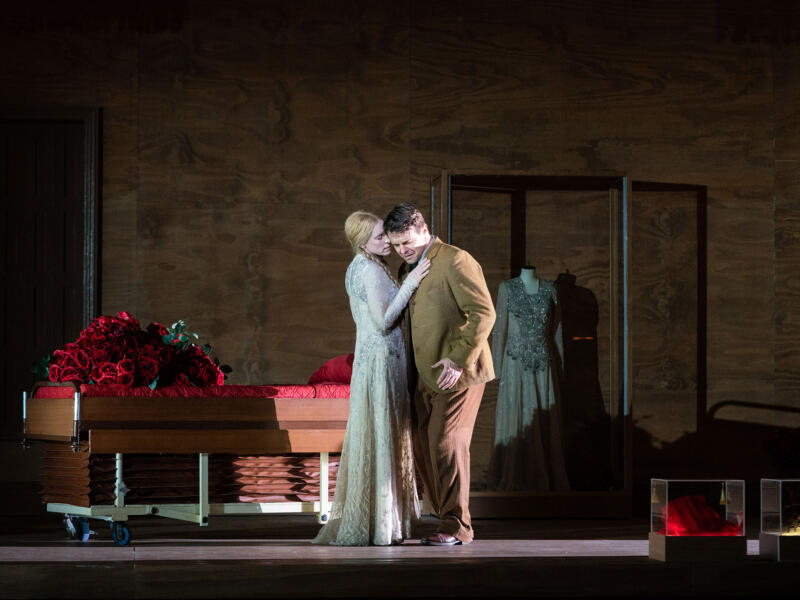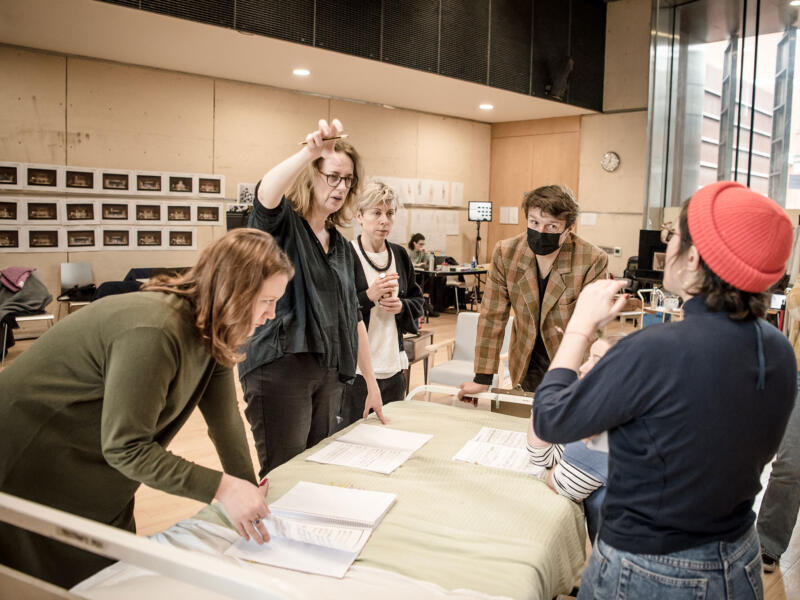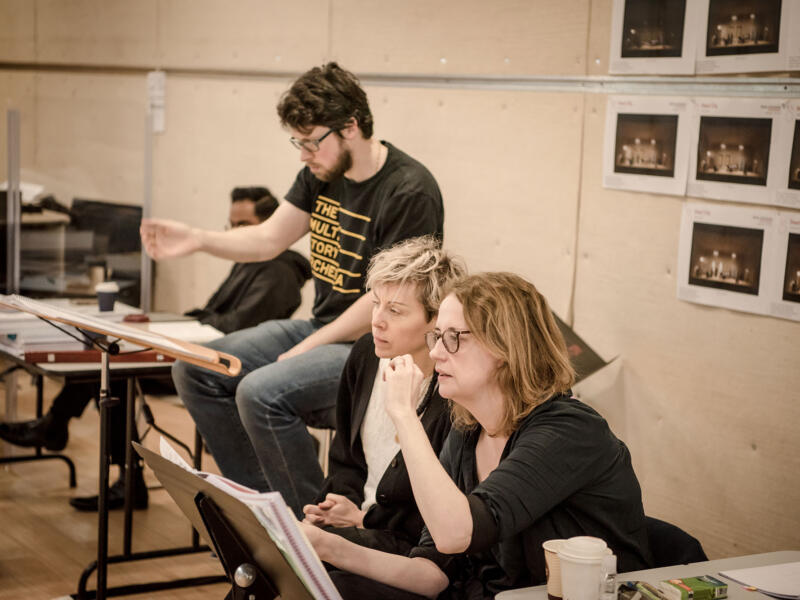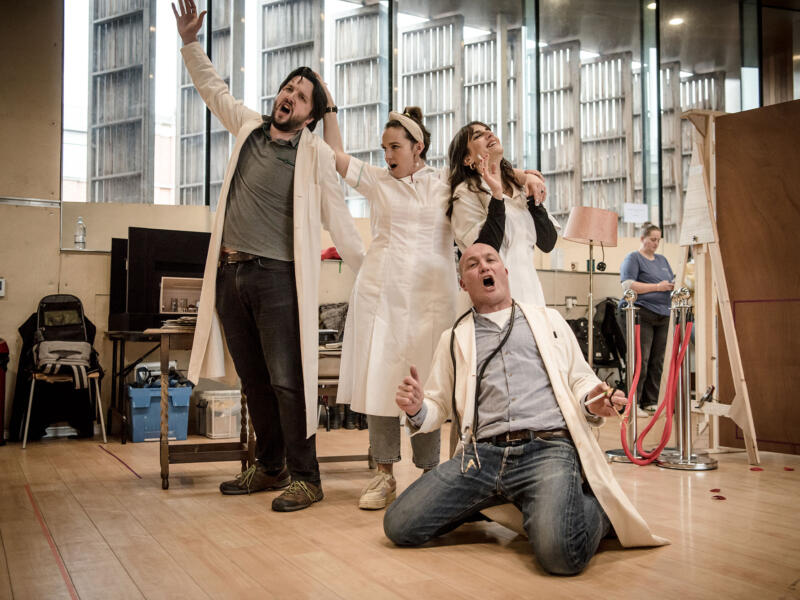Discover The Dead City
A haunting tale of romance and love lost combine with a series of hallucination sequences resulting in this operatic thriller: The Dead City.
One of the most influential pioneers in Hollywood score-writing, Korngold’s cinematic score features lush orchestral sounds and sublime music. Learn more about this heartbreakingly romantic opera in our synopsis of The Dead City (Die Tote Stadt), along with frequently asked audience questions and images from ENO’s 2023 performance of this cult classic.
Synopsis
Bruges
Paul has failed to come to terms with the tragic death of his young wife Marie and has lived and wandered the streets of Bruges alone for the five years since, cut off from life and human contact. He maintains a shrine to his wife’s memory in his house, including a braid of Marie’s golden hair. Until today, no one except Paul and his housekeeper, Brigitta, have had access to the room.
Act I
Paul’s friend, Frank, is visiting the city after a long absence. Brigitta shows him the shrine that Paul has created and is unnerved as he has unexpectedly announced that the house should be unlocked and filled with roses. Paul returns home, insisting that Marie is alive. He excitedly tells Frank about a woman he has met who so closely resembles Marie that he believes she has been reincarnated. He has invited the woman – her name is Marietta – to visit him at home. Despite Frank warning him of the dangers of such fantasies, Paul remains convinced that his wife has returned to him.
Marietta arrives at the house. She is a dancer with a visiting company who are performing Meyerbeer’s ‘Robert le diable’ at the local theatre. Paul places Marie’s shawl around her shoulders, recreating without revealing why, a treasured photograph of his wife. He asks Marietta to sing a song about two lovers who will soon be parted by death, which Marie used to sing. On discovering a picture of Marie and realising how similar they both look, Marietta is unnerved. She makes her excuses to leave, forgetting to take her umbrella.
Paul is torn between his loyalty to Marie and his fascination with Marietta. He begins to hallucinate and sees Marie alive again before his eyes. She urges him to admit that he is tempted by Marietta.
Act II
Paul’s hallucinatory state continues. He encounters strange visions from his subconscious, firstly Brigitta, who has left his service and joined a convent as a nun. She tells him she considers his taking up with Marietta a betrayal of Marie’s memory, despite Paul’s protests that he never broke faith with his late wife. Then a version of Frank appears and warns Paul that his attraction to Marietta is unhealthy, though it becomes clear that he himself is now a rival for her affections and keeps a token of her love.
Next, a gaggle of more Marietta admirers arrive, partying in advance of her expected arrival. This imaginary Marietta flirts with everyone but the seemingly invisible Paul, including Frank, who she asks to sing a serenade. She then suggests they rehearse a scene from ‘Robert le diable’ in which a character called Hélène will be irresistibly played by Marietta. Her allure in this role drives Paul mad with jealousy and he forces the performance to stop. Marietta sends her friends away before she and Paul argue violently. She finally realises that Paul’s obsession with her is because of her resemblance to Marie and decides to confront the challenge of her dead rival. Insisting Paul should love her for herself, he imagines she overcomes his guilt at finding her so sexually attractive. His fantasy of Marietta intends to sever the dead Marie’s hold over Paul, and he imagines them making love.
Act III The following morning – Paul’s fantasy continues
After spending the night with Paul, Marietta directly confronts Marie. Paul hallucinates a religious procession passing by. He observes the procession from the shrine: the prayers and music have awakened his remorse at betraying his wife. Increasingly exasperated by Paul’s obsession with death and the past, Marietta starts to taunt him by dancing seductively while stroking the braid of Marie’s hair. Paul is outraged by such desecration; he grabs the braid and strangles the imaginary Marietta with it.
Epilogue
Paul’s fantasy ends and the scene reverts to just moments after the real Marietta’s first visit to Paul’s house. Her lifeless body is nowhere to be seen and the precious braid of Marie’s hair remains untouched. He realises it was all an hallucination – everything is as it was.
Brigitta announces Marietta’s return: she has forgotten her umbrella and flowers and comes back to collect them. Frank returns and Paul tells him that he will not see Marietta again. When Frank declares that he is leaving the city, Paul decides to do likewise. The power that Marie’s memory exerted over him has been broken and he can pick up his life again – forever changed by grief and loss.
What does 'Die Tote Stadt' mean in English?
Written by Austrian-born composer, Erich Wolfgang Korngold, the German opera ‘Die Tote Stadt’ means ‘The Dead City’ or ‘The City of the Dead’ in English – hence why the two titles are often used interchangeably.
How long is Die Tote Stadt?
A performance of The Dead City at the ENO’s London Coliseum is roughly 2hrs 40 mins with one interval.
Who wrote Die Tote Stadt?
The Dead City was composed by American composer, Erich Wolfgang Korngold (1897-1957), one of the most influential pioneers in Hollywood score-writing. Known for his dual disciplines of cinematic and classical compositions, Korngold became a hugely influential figure in the sound of Hollywood for decades to come and the roots of this can be found in The Dead City’s remarkable cinematic score.
When was Die Tote Stadt written?
The Dead City was written in 1920 and was adapted from Georges Rodenbach’s 1892 novel Bruges-la-Morte.
What is the story of Die Tote Stadt?
The Dead City follows the story of Paul, a widower who is haunted by the death of his wife Marie. When he meets the all-too-familiar Marietta, the lines between past and present blur, and reality itself is called into question.







